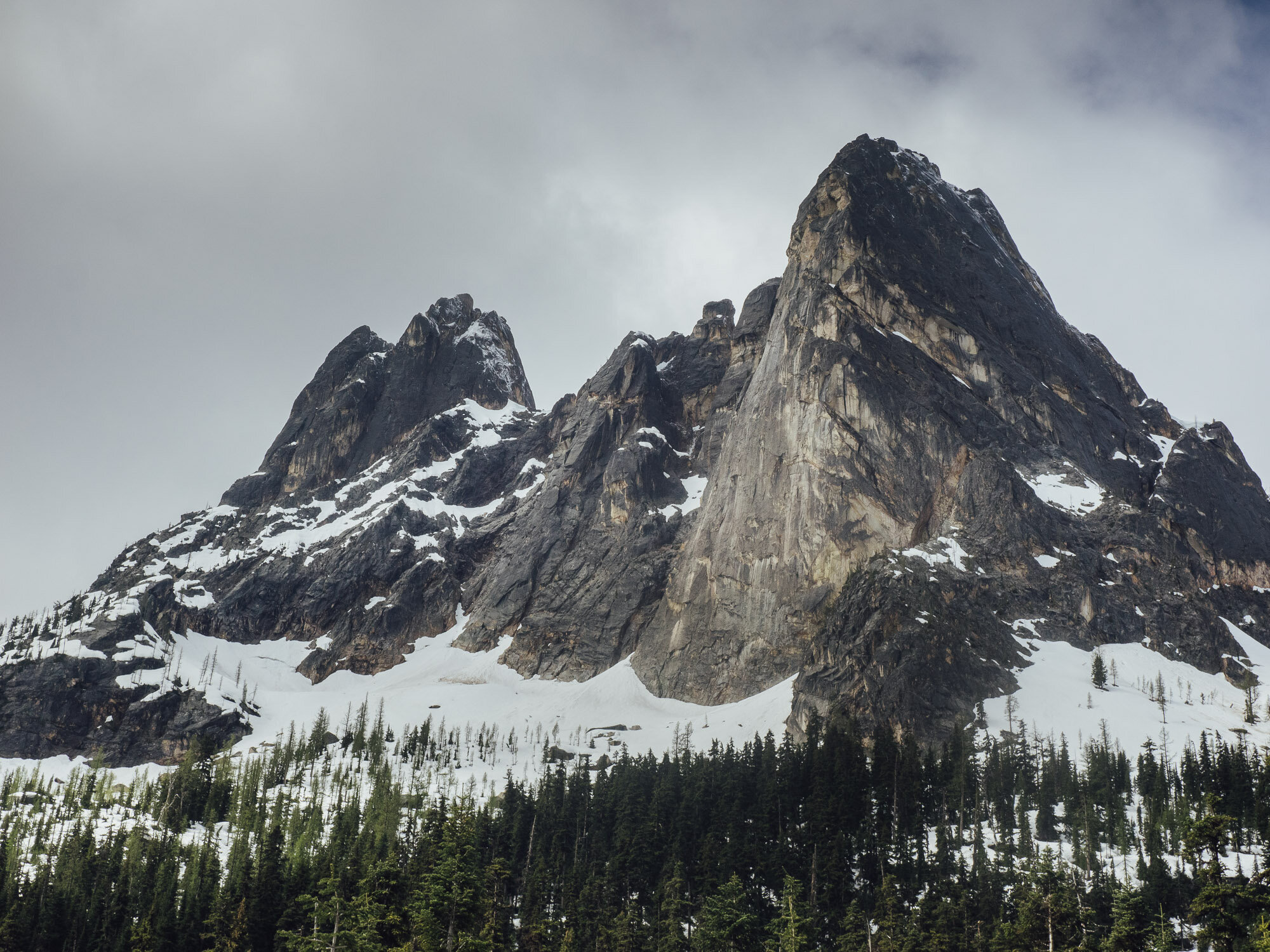
Dark Side of Liberty
Mikey Schafer, with his partner Shanjean Lee, established yet another free line on the east face of Liberty Bell this summer. Their new route, “Dark Side of Liberty,” an 11-pitch, 350 meter 5.13d, is Mikey’s hardest new route to-date and is now Washington’s hardest multipitch route. So the route is hard, but it is also really, really good. The climbing on it is ridiculously fun, shocking sometimes in its quality.
Mikey and SJ spent a chunk of the last two summers working on the route. I kept hearing about how cool it was, that an improbable steep section of Liberty Bell was shaping up to be quite promising. There is not much, if any, room left on the east face for completely new routes. Their’s might be the last. The line goes for some undeveloped orange, choosy-looking rock of the far right side of the face, right before it turns to the slabby north side. The first four pitches, characterized mostly by face climbing with some gear here and there, are the hardest. The rock on these pitches is impeccable, with some of the coolest granite holds I’ve ever touched. Pitch 2, the best pitch on the route, is a wonderful sustained adventure through edges, crystal pinches, a roof, compression slopers, a lip traverse, and more…
The crux pitch, pitch 4, starts out with some cool 5.12 bouldering into nice, 5.12- fingers in a small corner. A good jug allows you to recover for a thin tech V9/10 boulder, immediately followed by a powerful V5/6 prow boulder. And since we're on Liberty Bell, it’s capped with a final, no-hands slab stand-up move. The difficulty of the crux definitely stands out, and it’s possible the route would be better if it wasn’t as hard there, but the quality of the pitch I think is still quite good and it would be easy to pull through the hardest section if you wanted to climb the route at 5.13a A0.
The upper 5.11 pitches are a nice contrast, taking mostly gear. A couple pitches need some traffic to clean up a bit more, but are still quite nice.
I spent one day working out the first four pitches and came back the following week to try to send the route. It took me three tries to send the first pitch (5.12d), which I had onsighted my first day on it. It wasn’t a great start. I sent the second pitch (5.13a) first go, which probably doesn’t have a move as hard as the first pitch, but is overall much more sustained. At the crux fourth pitch, I fell a third time that day on the last move of the boulder, but was able to send second-go. I was able to onsight the final seven pitches, though the 5.11 pitches are not gimmes. The route did not go down without a fight. After climbing the Canadian Rockies Trilogy just a few weeks earlier, I’d say that the difficulty of the Dark Side of Liberty is right up there with these routes. The quality certainly is.
Mikey already has a great topo posted on Mountain Project with good pitch-by-pitch descriptions. Congratulations Mikey and SJ, and thank you for the great contribution to Washington climbing!
Austin Siadak took the few photos below, except for the last one, which I took. Thanks Austin for letting me post these here!
Mikey working through sculpted crystal pinches on the amazing 2nd pitch. Photo Austin Siadak.
SJ on the crux pitch. Photo Austin Siadak.
SJ on the 5th pitch. Photo Austin Siadak.
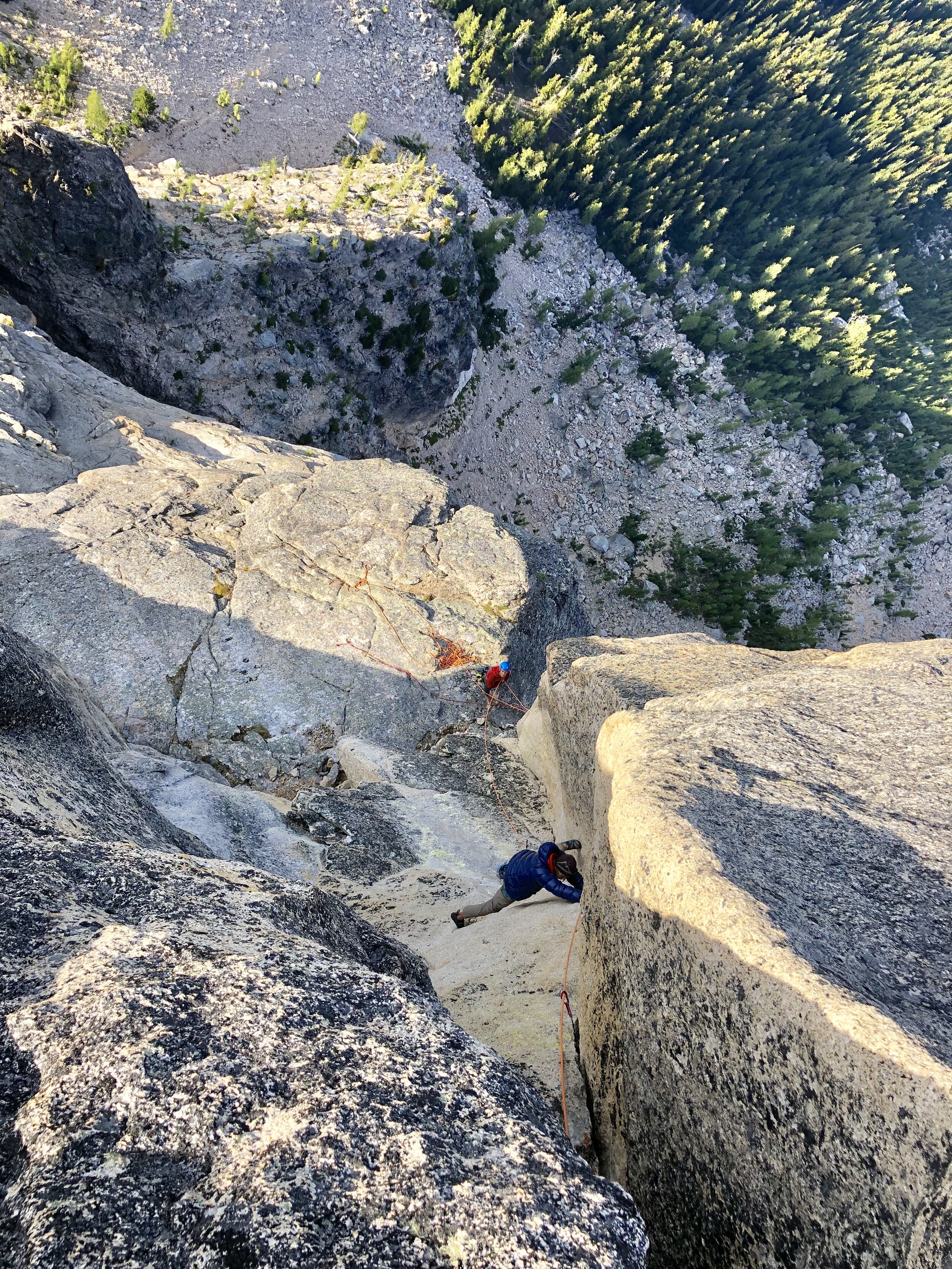
Blake Herrington on the final steep 5.11 pitch.

The Bugaboos
Mike Kerzhner and I started our four week stay in Canmore with a stop at the Bugaboos. Neither of us had been and we thought a little dose of alpine climbing would make us thankful for the Canmore bolted limestone. Mike and I met in El Chaltén, so it would be fun to check out this “mini-Patagonia” together.
Mike drove up from Portland and picked me up in Seattle. On the drive we discussed our options. We could try one of the harder free lines on the easily accessible Snowpatch Spire’s east face. Or we could try to link a few moderates and get a tour of the area. Or we could go all in on All Along the Watchtower, a remote and long climb on North Howser Tower. All Along the Watchtower was the first climb I knew about in the Bugaboos, listed inFifty Favorite Climbs. I’d looked at it for years, and was naturally drawn to doing it. It seemed to be the Bugaboos classic big objective.
After spending a night in the truck, we finished the drive, taking the longest of dirt roads to the trailhead. It had been raining all morning and we were hoping to make the six hour approach to East Creek Basin that day to be set up to climb the Watchtower. The rain didn’t let up and we didn’t feel like slogging through it for several hours, so we decided to adjust our plans. No Watchtower this time.
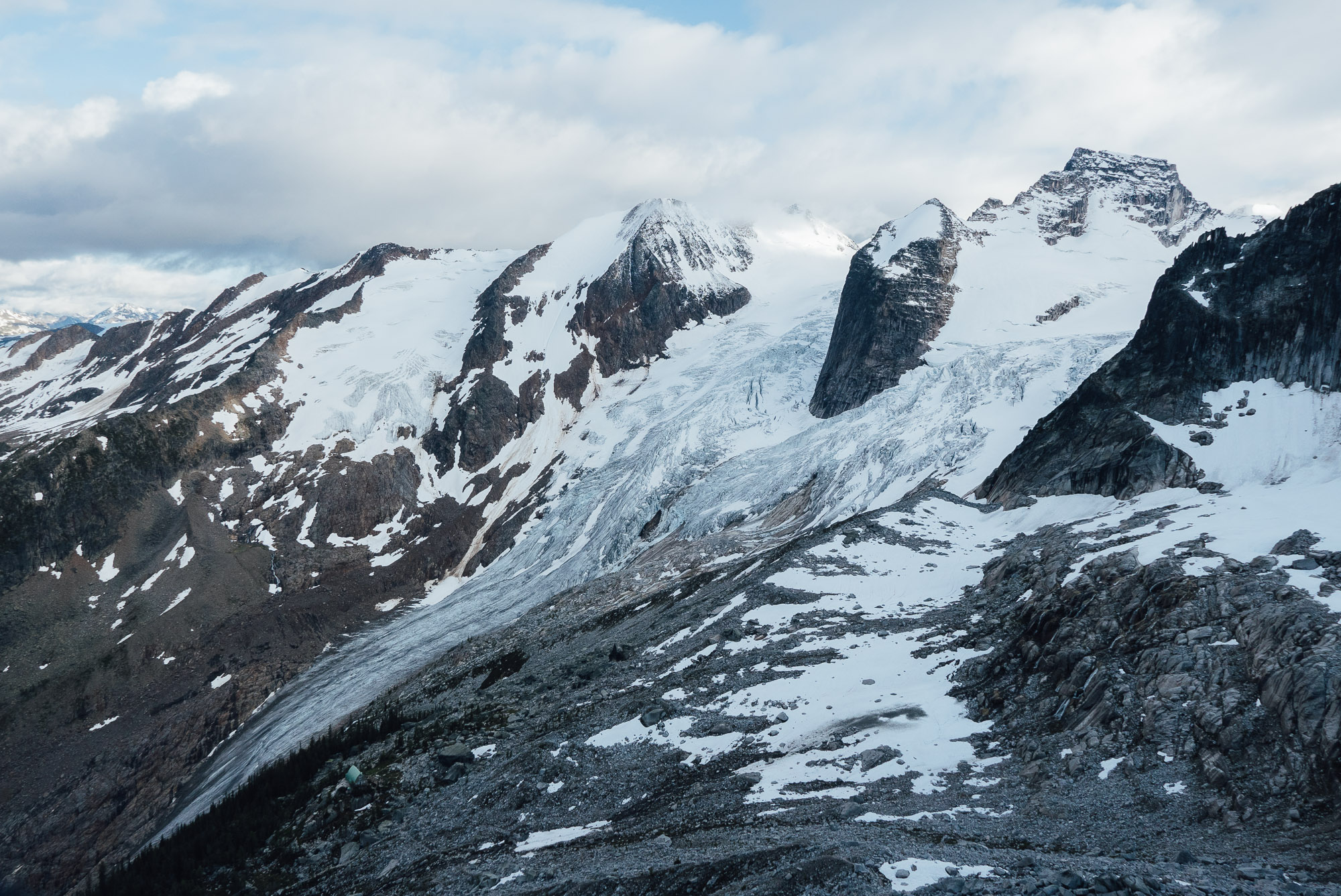
Kain Hut (bottom left) from Applebee Camp
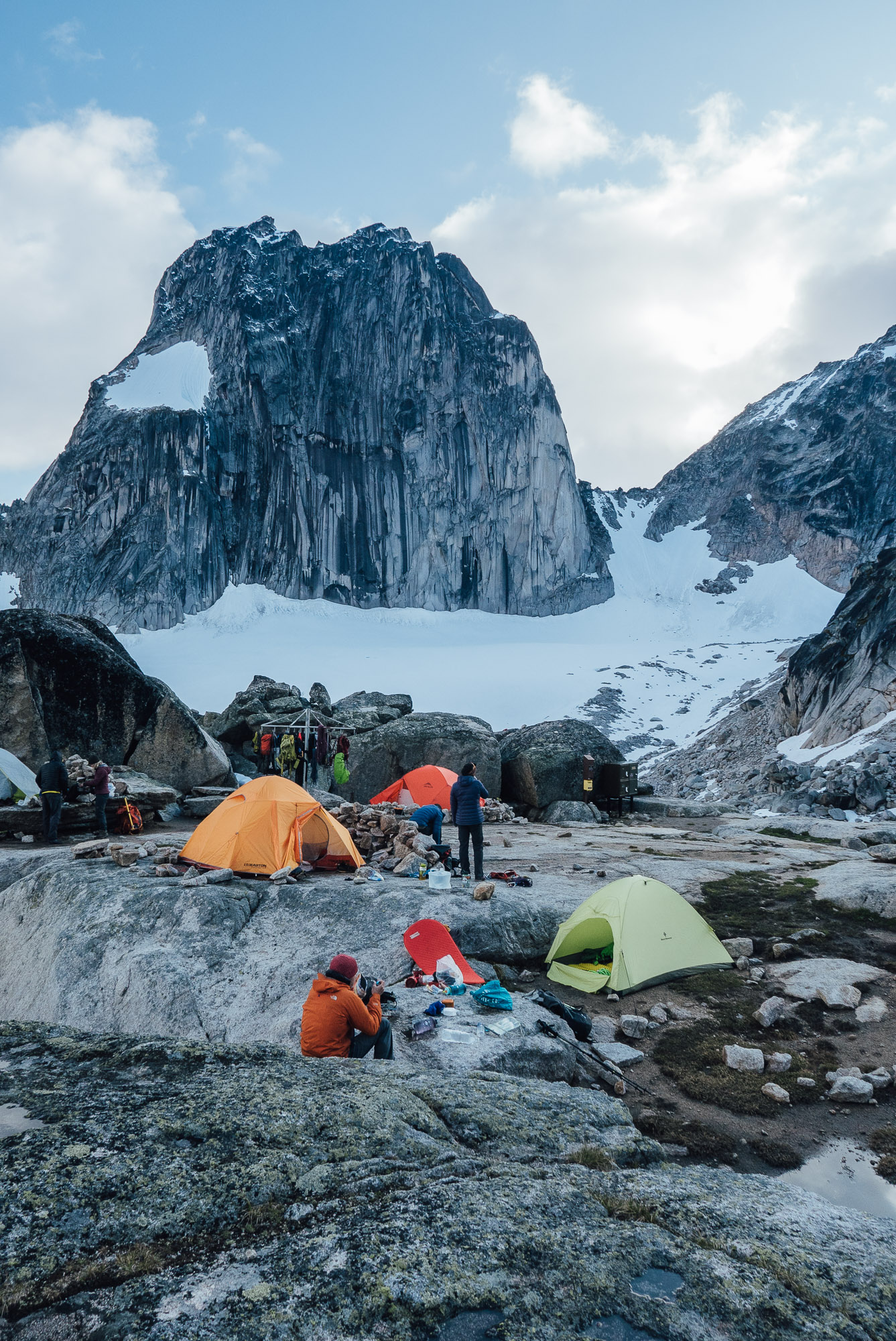
Applebee Camp
We waited out the rain and made the three hour approach to Applebee Campground, the main climber’s bivy. The next day we’d try a reasonable link-up of two classics—the Northeast Ridge of Bugaboo Spire and the Becky-Chouinard on South Howser. Several parties have climbed these two routes plus a few more all in a day, so our plan didn’t feel like it would be that ambitious.
Upon arriving at camp and finding a spot amongst the hundred or so other climbers camped there, we discovered we were walking into a long overdue opening in the weather. We also head that the rain had fallen as a foot of snow higher up. Having never been there we weren’t sure how to take in all the information and adjust our objectives. But I figured starting with an easy classic would be a safe bet. We could deal with some snow if there was any on Bugaboo Spire. And we didn’t have to link into South Howser if conditions were slow.
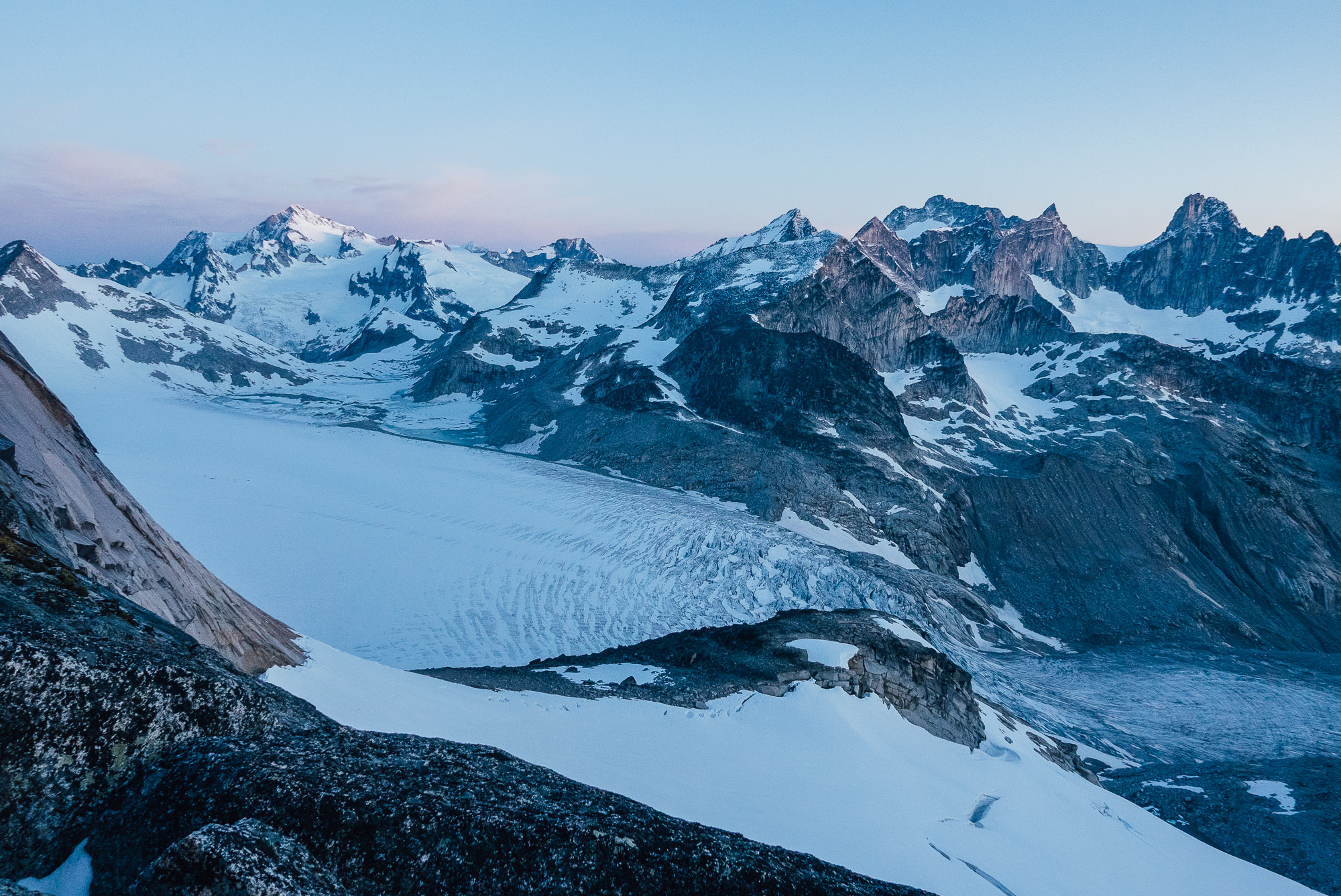
We set our alarms for 4am and were hiking by 5am. Sure enough, the NE Ridge of Bugaboo Spire was wet and covered in snow, pretty much in winter condition. I took the first block, simuling through the 5.7-5.9 pitches low on the route. Mike took over but we quickly realized he was out of his element, attempting to lead snowy low-fifth in a pair of downturned Scarpa Instincts. I took back the lead and took us to the summit which involved lots of tromping through snow in rock shoes, digging out handholds, and skooching across snowy knife-edge ridge.
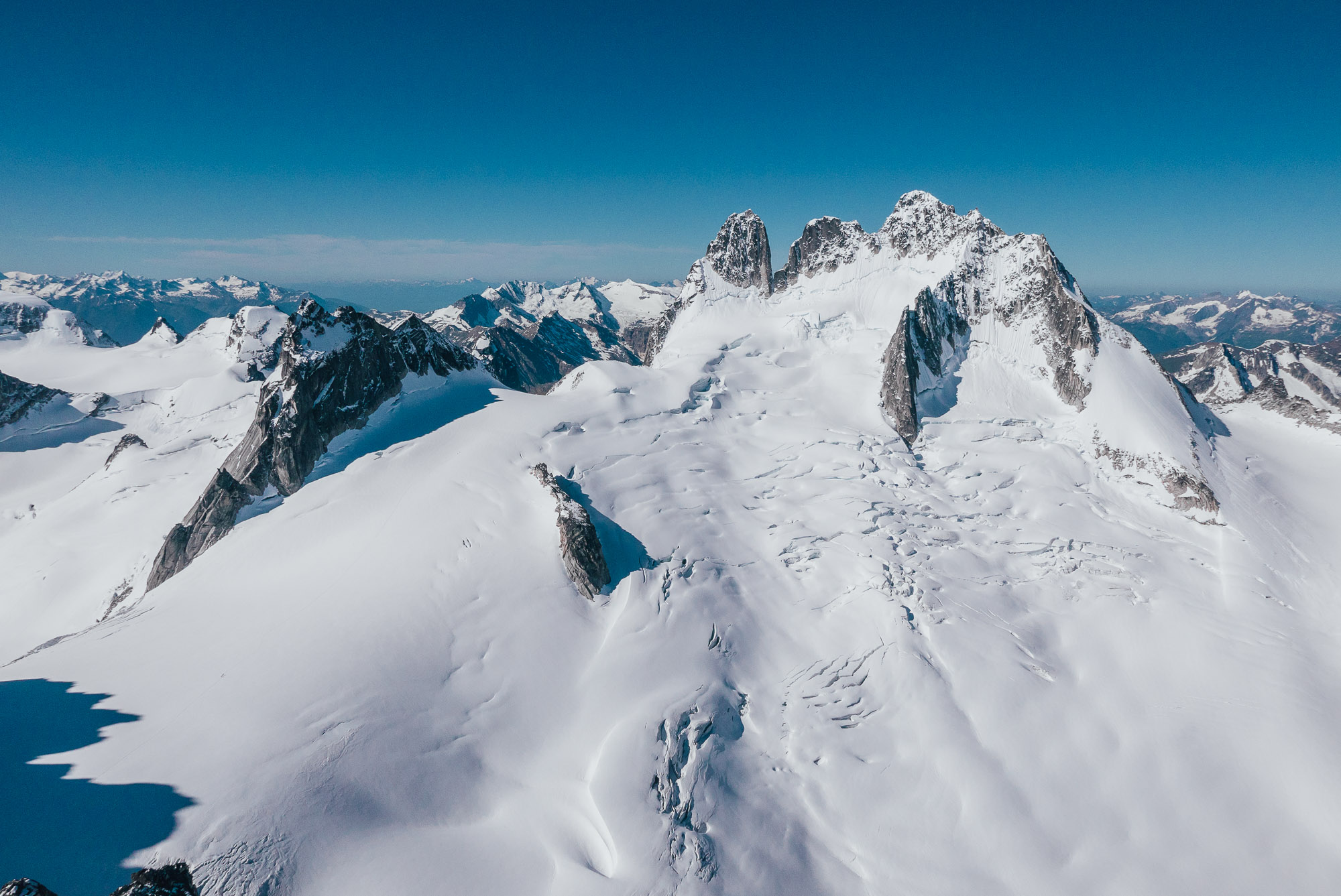
Pigeon Spire and the Howser Towers
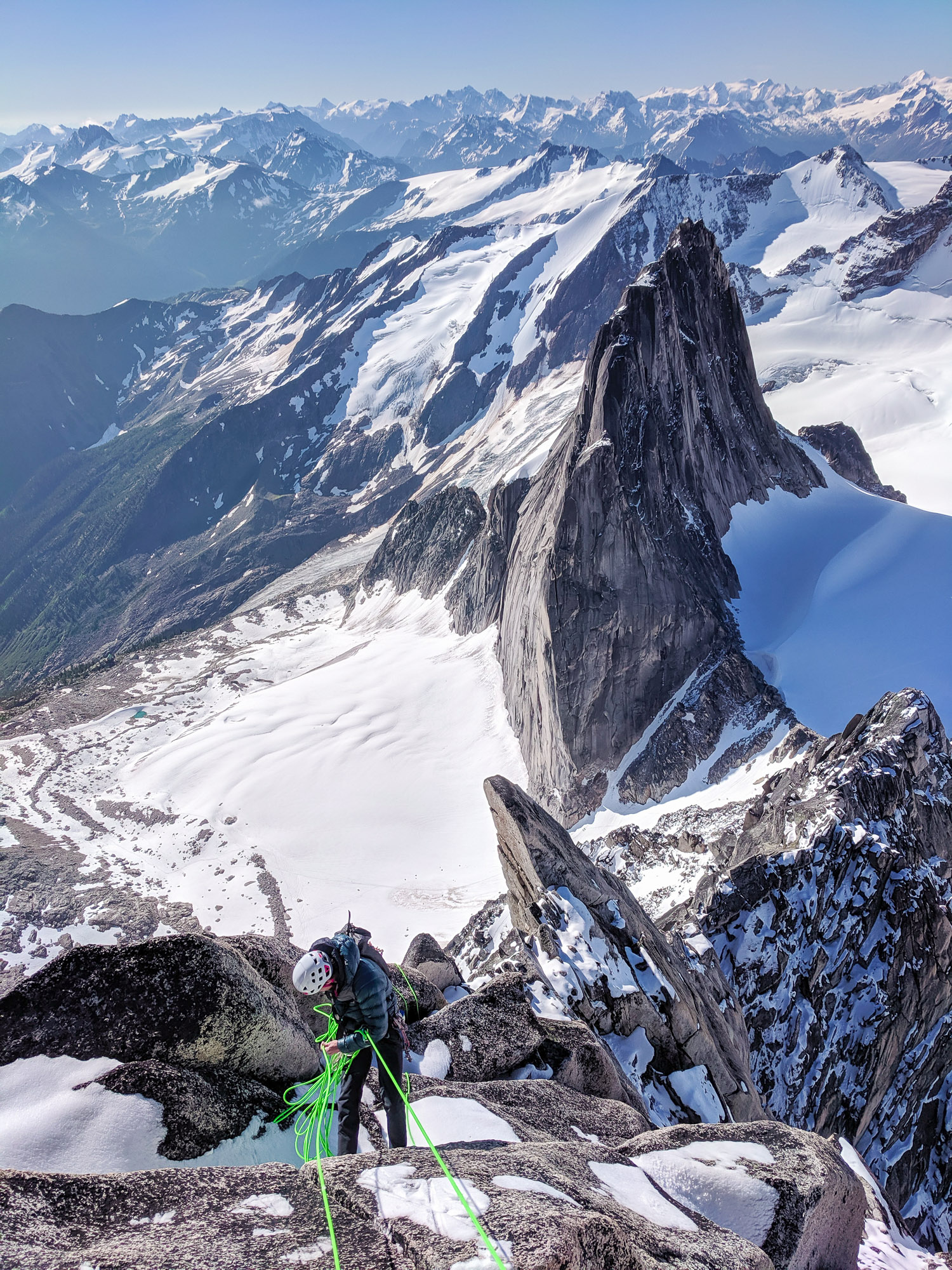
Me rappelling from the summit of Bugaboo Spire
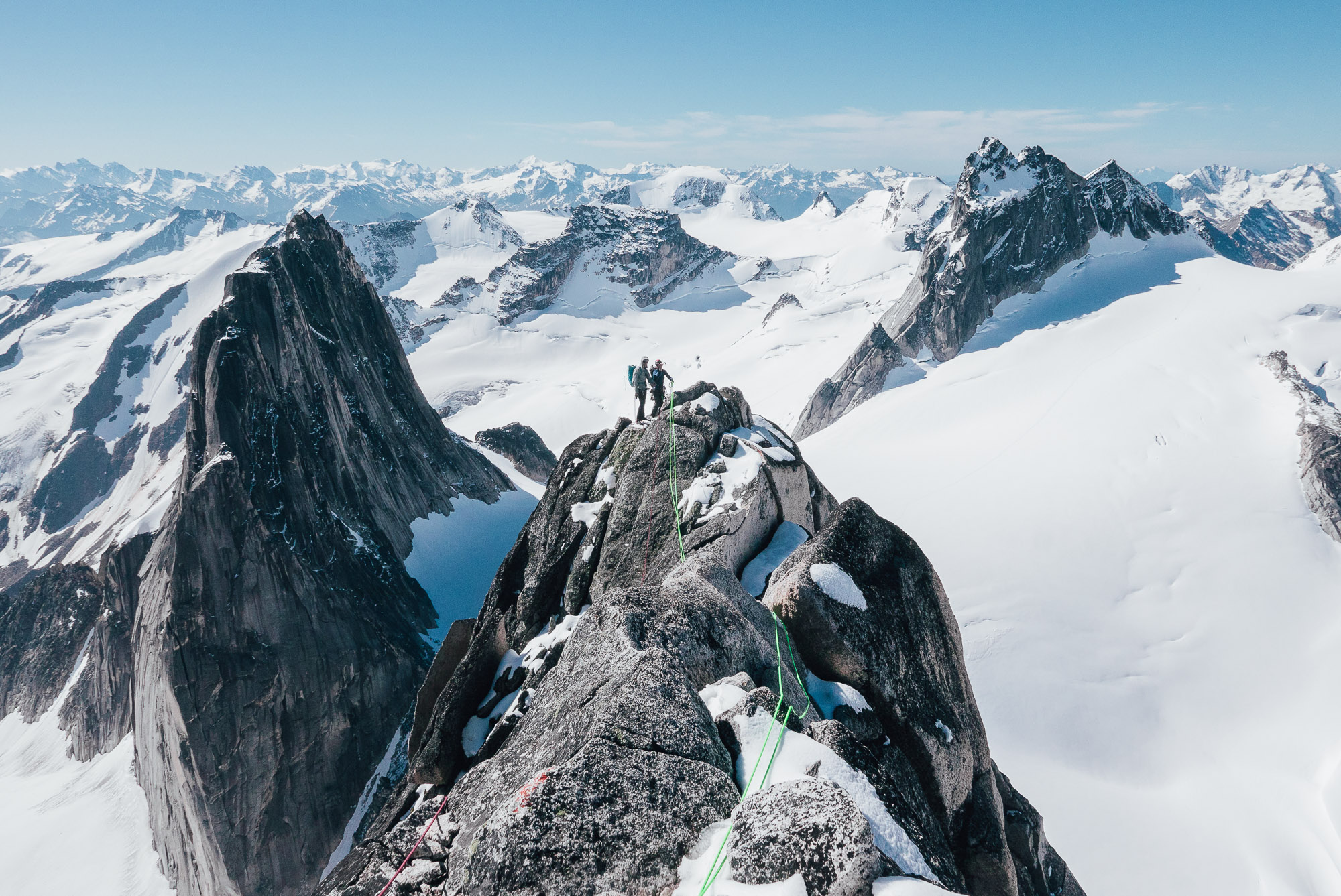
Descending the Kain Route on Bugaboo
We didn’t stay on the summit long because we were just standing around in a bunch of snow. We did a few weird rappels and made it down most of the Kain route until we got to a dry spot to have a snack and decide what to do next. Even though it was still morning, attempting to climb South Howser in these conditions seemed a little more alpine than we wanted. We ran into some climbers who had checked out a popular climb called Surfs Up on Snowpatch but bailed because it looked too wet. We took a photo of their topo and decided to go have a look ourselves, hoping it had dried out a little in the sun since they looked at it.
We made the short and easy walk across the glacier to the base of the route and stared up at it in indecision. Snow and ice was occasionally falling off the route. It started in a wet and snowy looking corner, which wasn’t inspiring, but we had nothing else to do with our day. It was only noon. The route was only “5.9” so we were sure we could probably still get up it wet. The first few pitches turned out to be more than we bargained for. Where the route usually climbs was snow and ice so we had to climb to the left through wet and mossy disjointed cracks with weird protection. Mike had to lead through a waterfall. We creeped through these pitches though and made it to dry splitter cracks that quickly and enjoyably took us to the summit of Snowpatch.
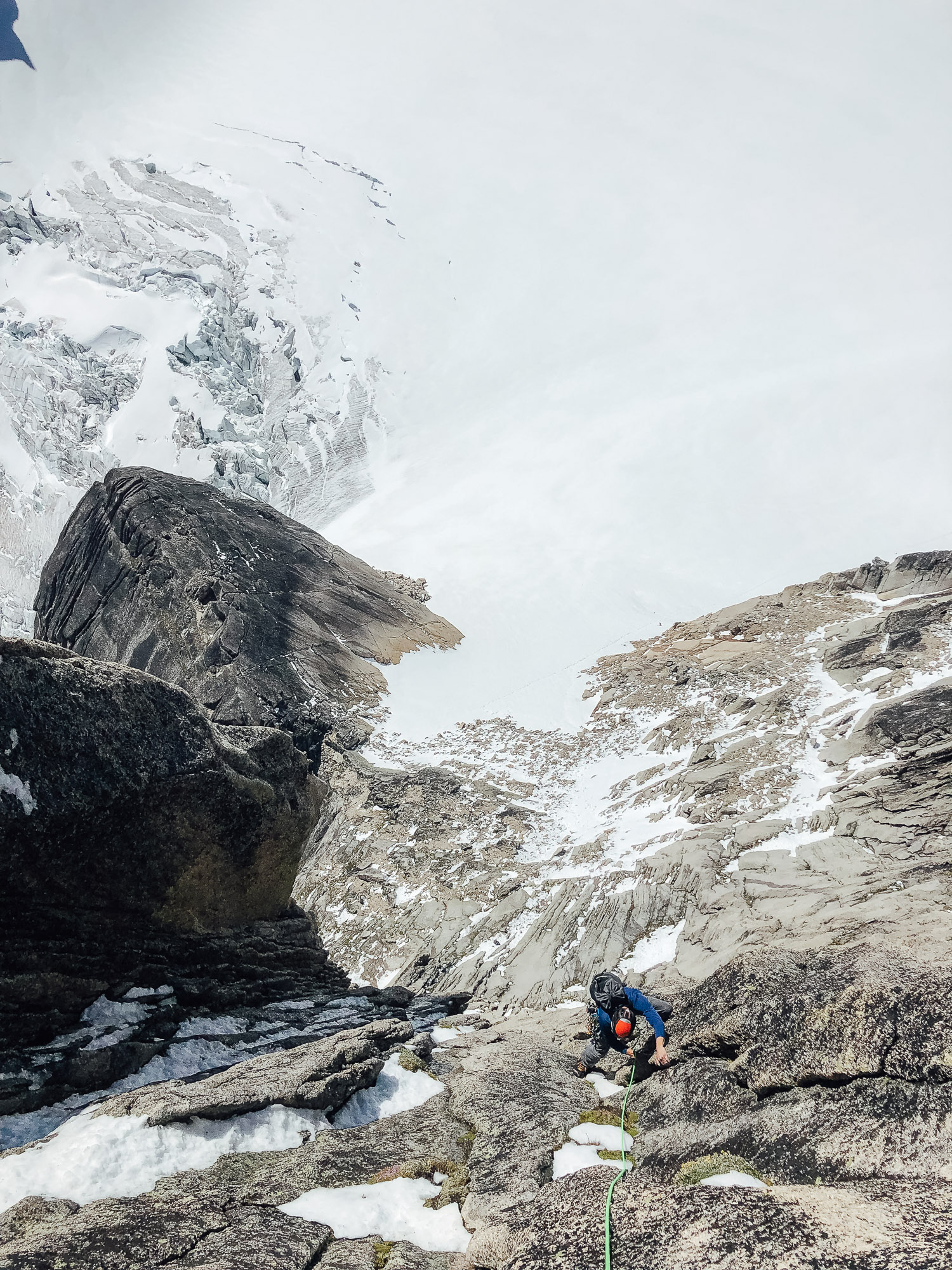
Mike on the 2nd pitch of Surfs Up
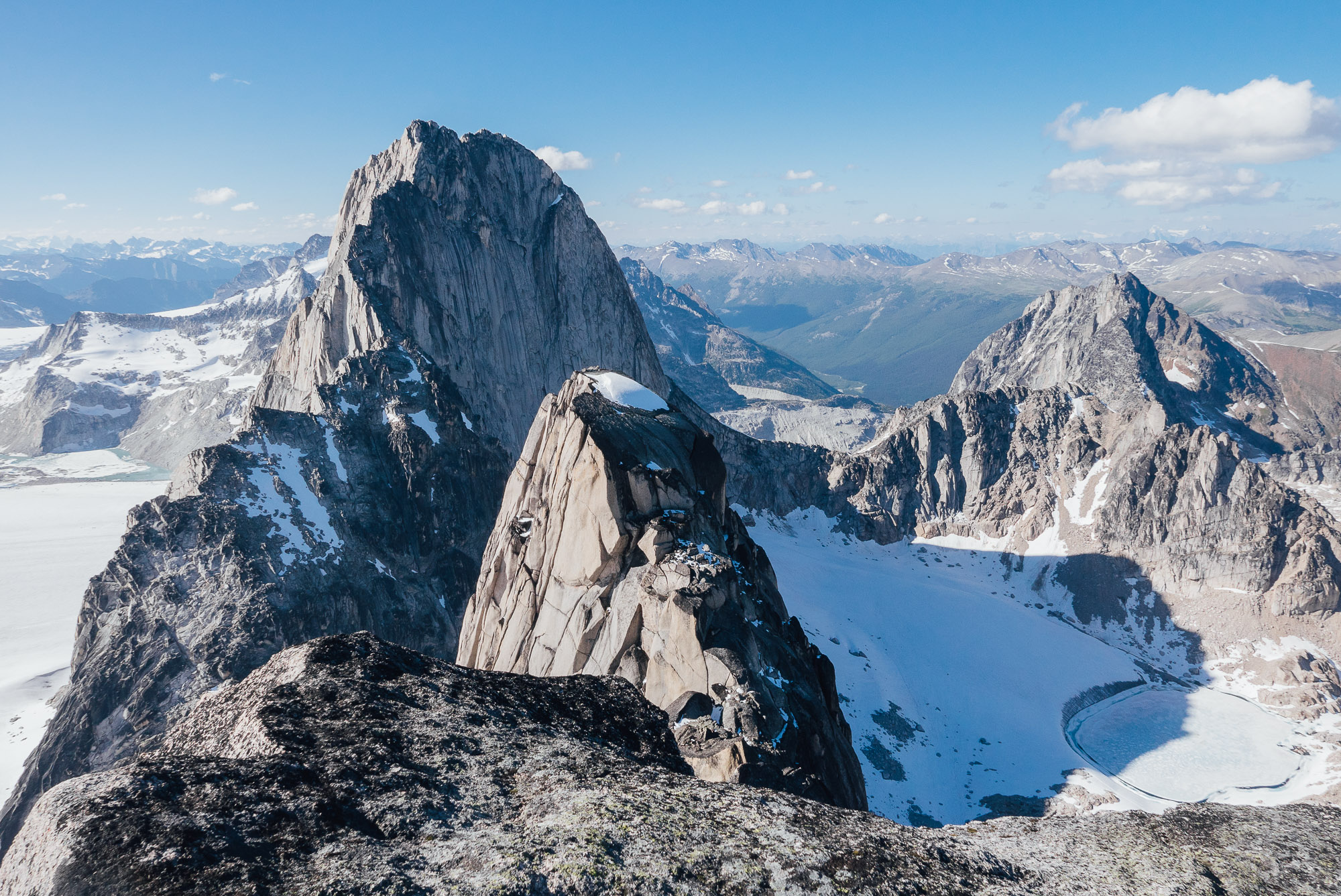
Looking from the summit of Snowpatch over at Bugaboo Spire
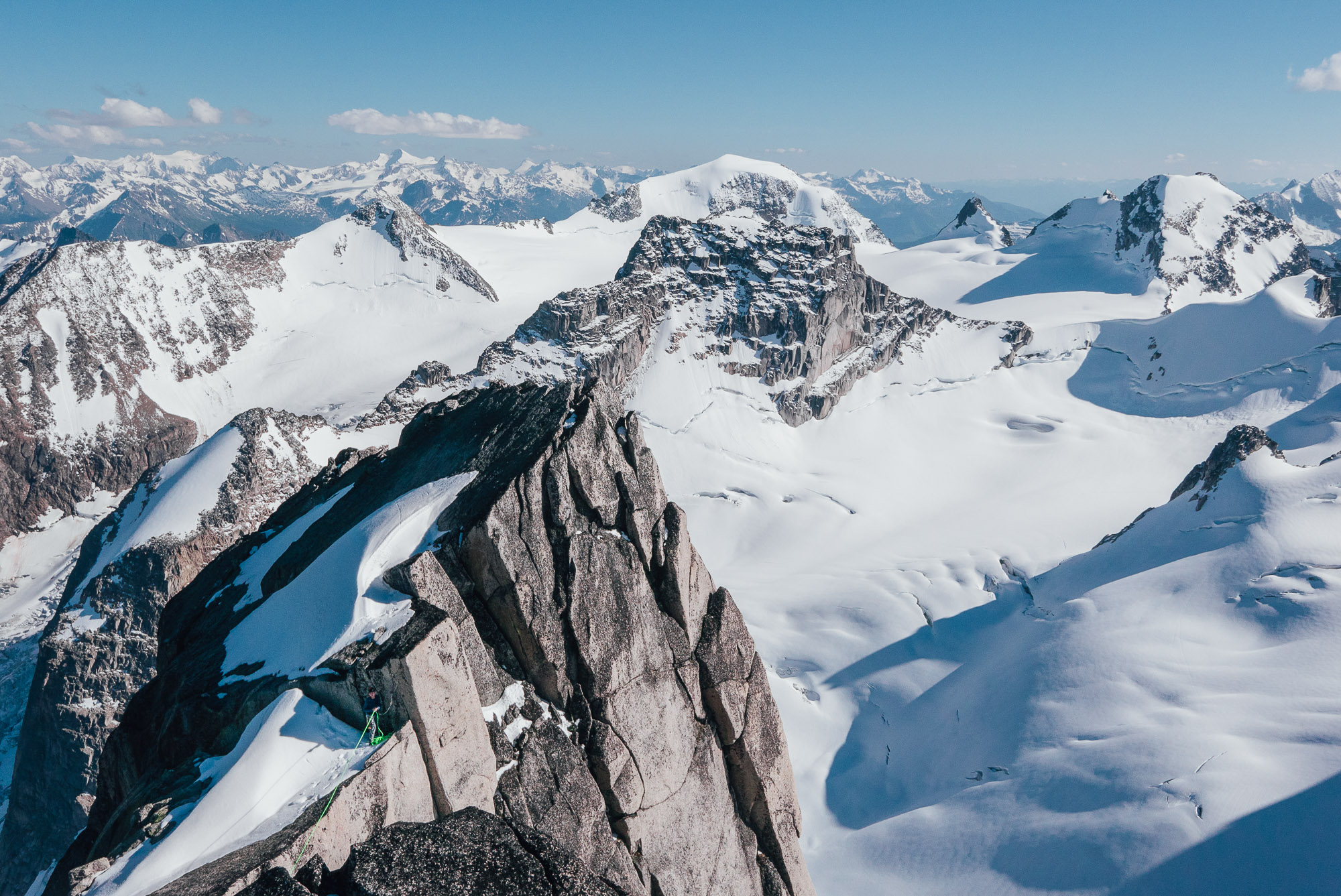
Mike getting ready to descend Snowpatch
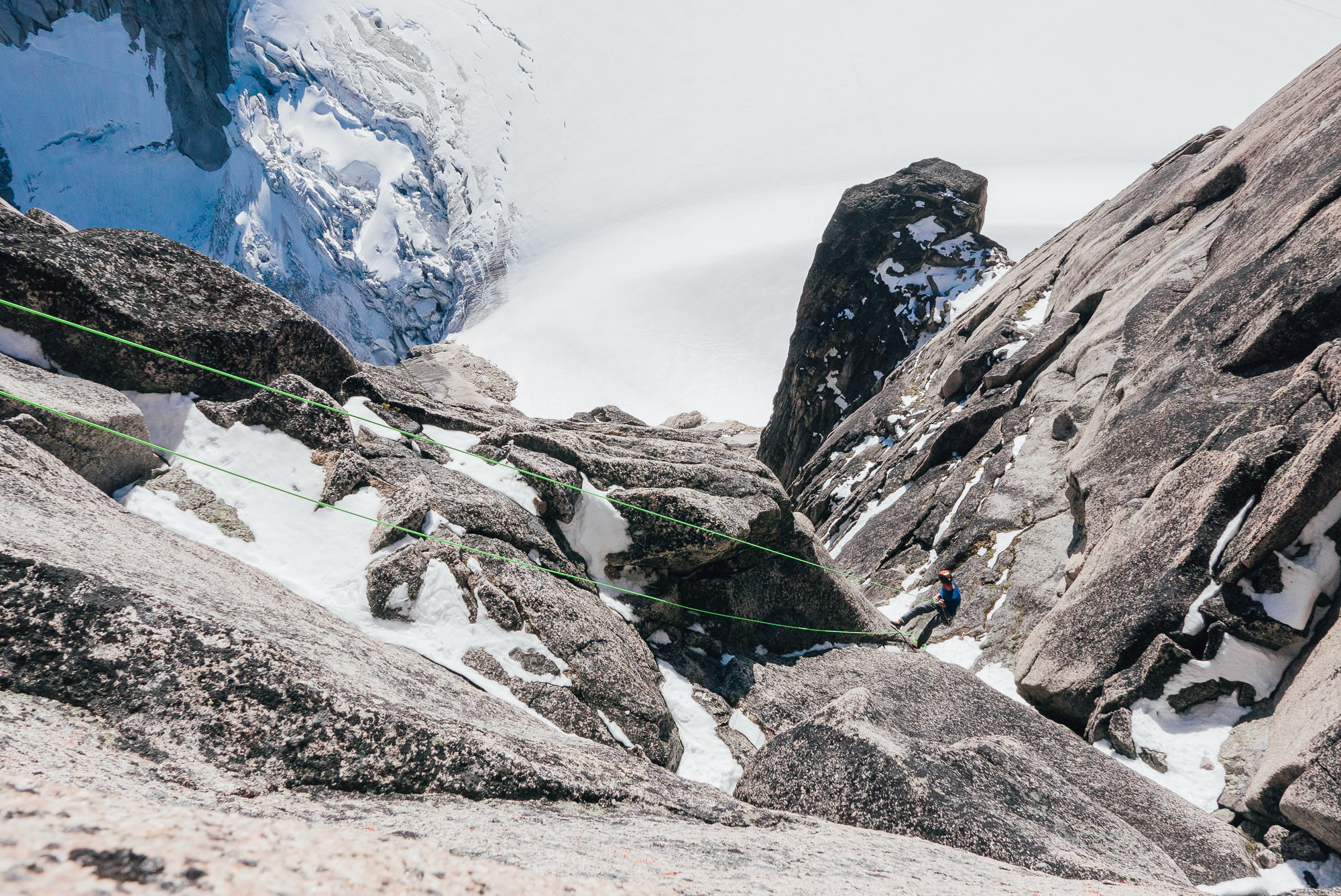
Mike on the first rappel down Snowpatch
We enjoyed the views and looked across the way at Bugaboo Spire, relishing the fact that we had been standing on it earlier that day. After a snack we went down the normal rappels which follow a huge corner system. It was a trap for snow and water, and the whole thing was a giant waterfall. Exciting! Luckily it was still in the sun and we were able to stay warm.
The next day we chose a shorter objective—the classic Sunshine Crack on Snowpatch—so we could hike out and make the 3.5 hour drive to Canmore at a decent time. The approach is an easy 45 minute jaunt across the glacier from Applebee. At the base of the climb we met two Chilean climbers who only had one 60m rope and needed another party to climb with them so that they could get down. I made a deal with them that if they let us go first we would rappel the route with them.
The first few pitches were wet, including an offwidth waterfall. The upper two thirds of the route was dry though and the climbing was amazing—one of the highest quality mostly 5.10 routes I have ever climbed. We set the pace and our Chilean friends kept up. We descended together and Mike and I booked our way out of the Bugaboos. It had been a fun couple days of climbing in one of the most beautiful places I’ve ever been.
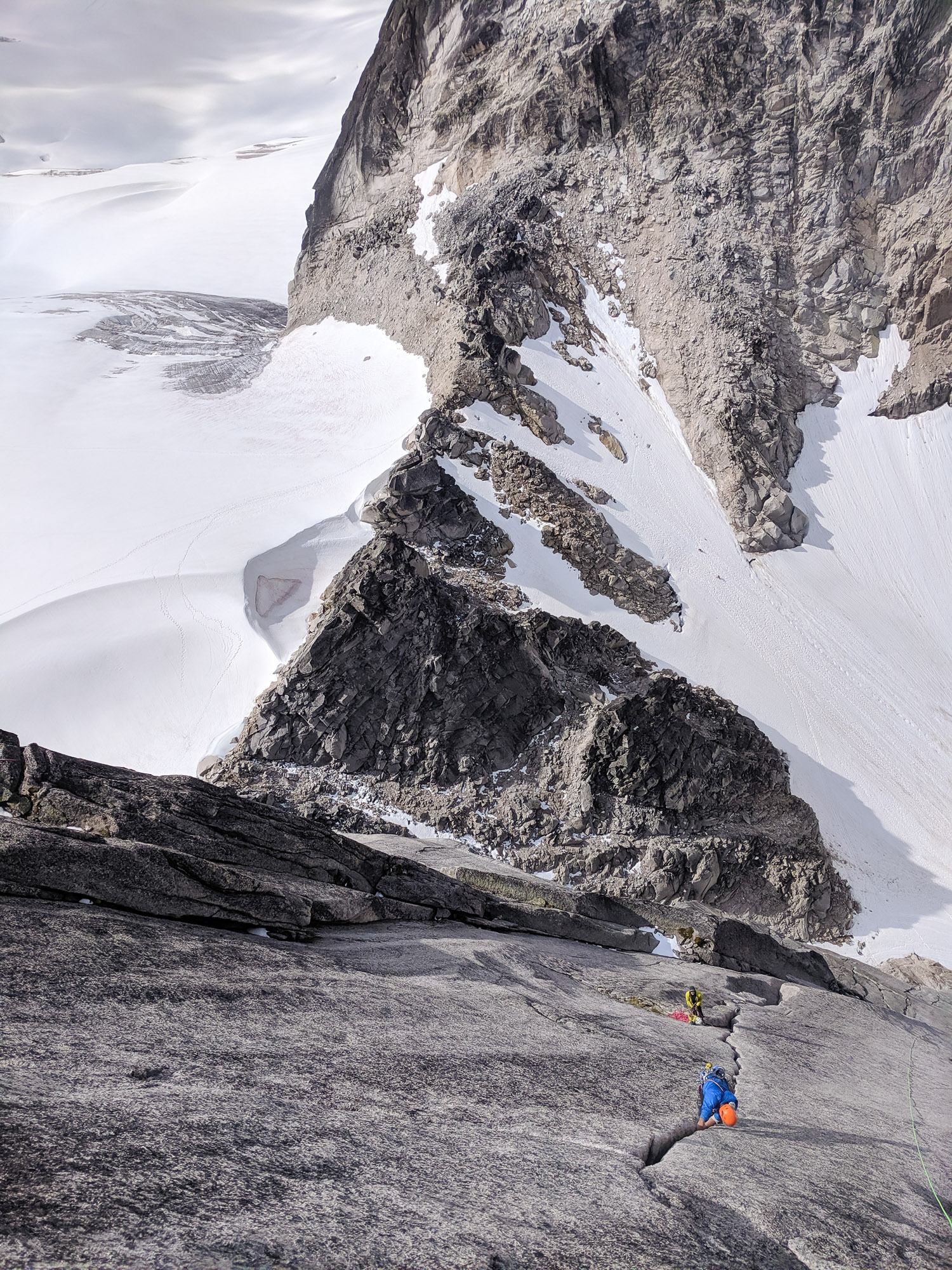
The Chileans on the last pitch of Sunshine Crack (photo Mike)
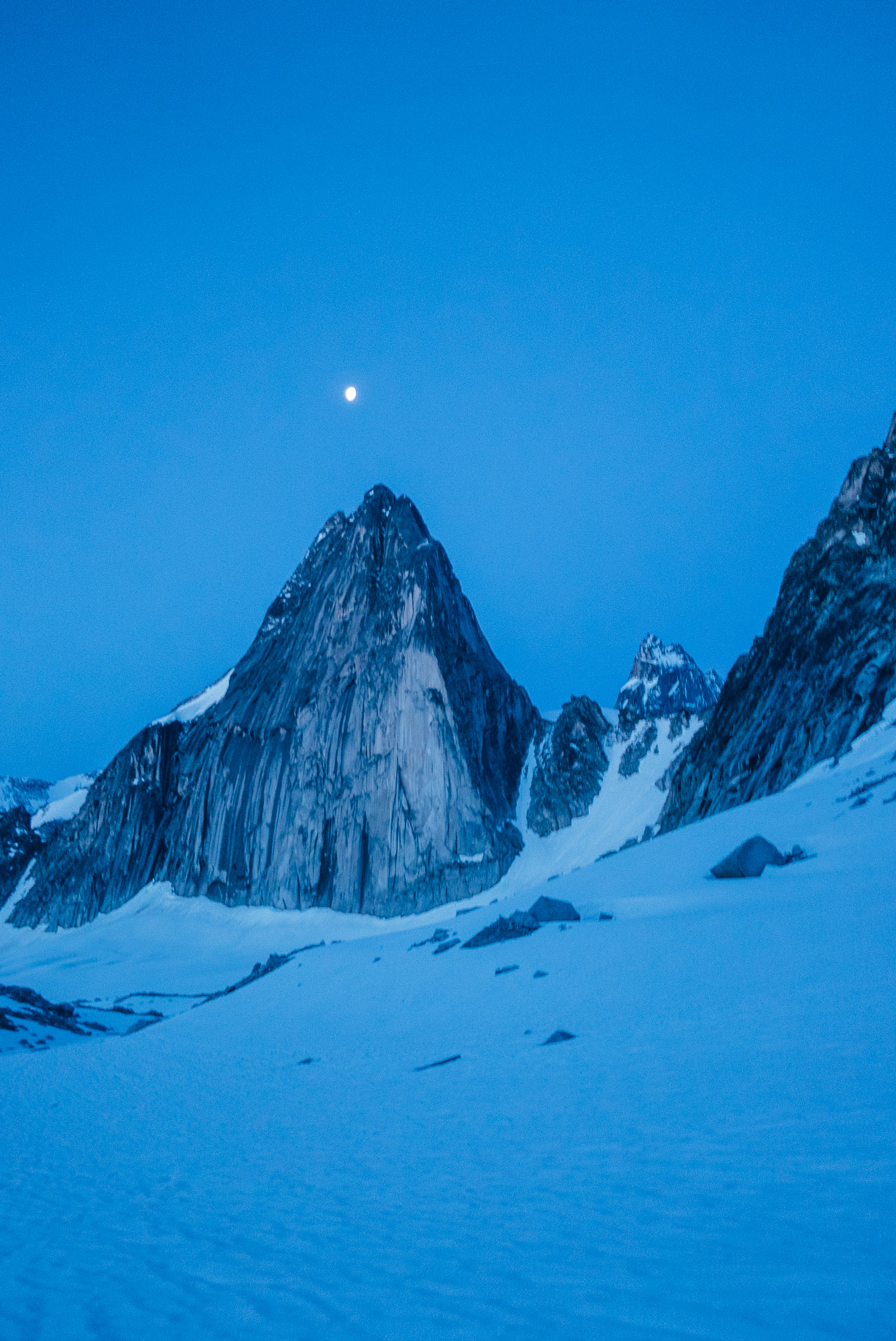
Snowpatch Spire
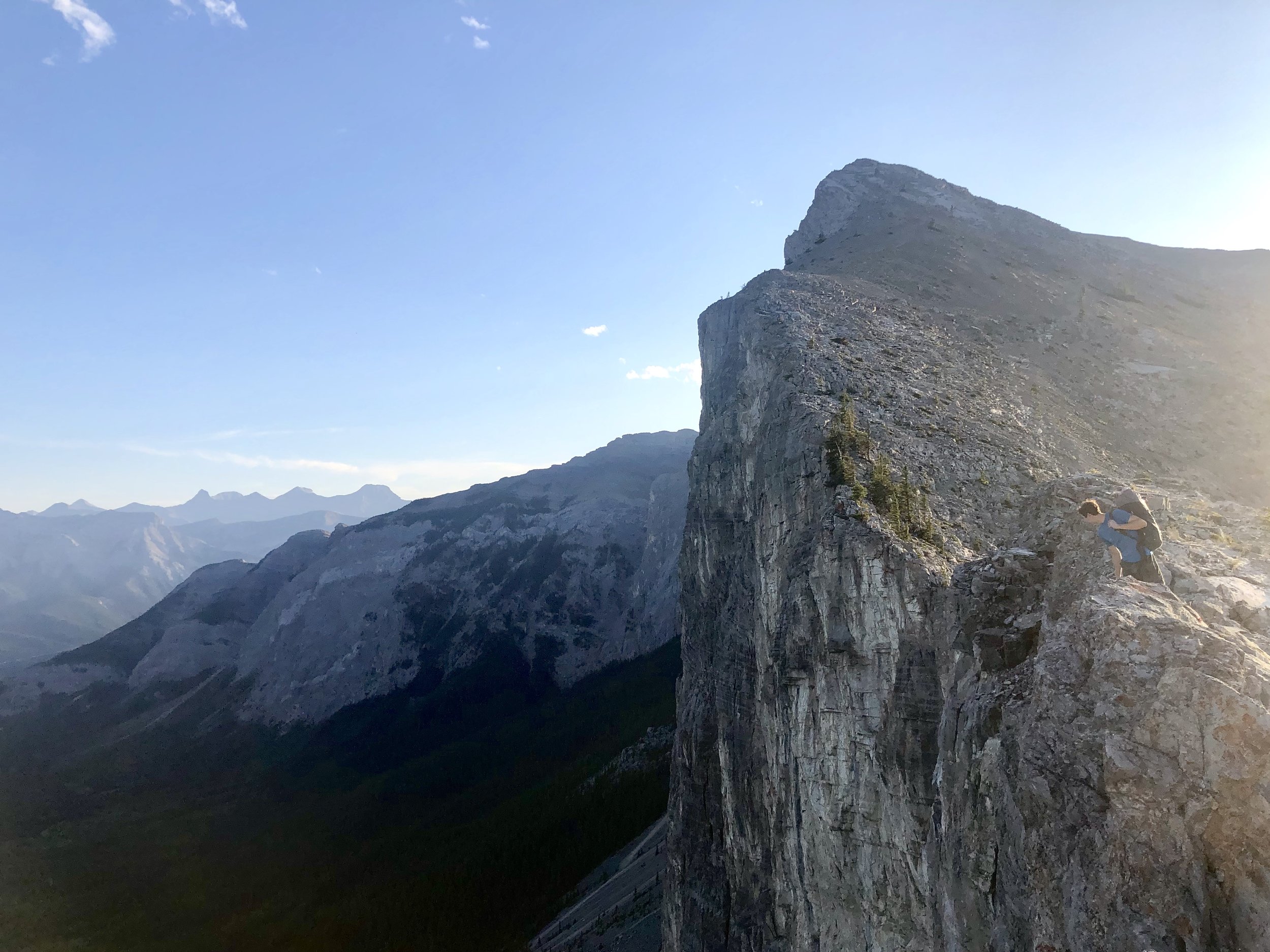
Mike looking over the edge of Yamnuska, where Blue Jeans tops out.
Blue Jeans Direct: The End of the Canadian Rockies Ticklist
Mike and I both sent Blue Jean Direct on Mt. Yamnuska last Wednesday, our second day on the route. Blue Jeans has become a somewhat well-known hard multipitch route, one I’ve known about and wanted to do for a while. When it first went up at 5.13b, 7 pitches, in 2010, it was the hardest multipitch route in the Canadian Rockies. Since then, a handful of harder routes have gone up, including Sonnie Trotter’s variation of Blue Jeans, “Blue Jeans Direct.” Sonnie’s variation replaces the 5th pitch of Blue Jeans with a harder, more direct variation. It’s a short pitch that basically dumbs down to a fun V9/10 boulder through an overhang. Sonnie called it 5.14a.
The whole route is pretty sustained. The pitches break down at 5.12b, 5.12d, 5.12d, 5.13b, 5.14a, 5.12a, and 5.10d. Yamnuska is south-facing and lower elevation relative to the other walls we’d been on, so the heat presented a challenge. We had to hike to the base of the wall in the blazing sun and climb the first few pitches before the route went into the shade around 5pm. The sun plus the difficulty of the pitches leading to the crux zapped us on our first day on the route. We needed full strength for the powerful crux, and by the time we had figured out what to do, we were too tired to give it any good attempts.
On our second day we were able to get to the crux a little more fresh, despite the beach vacation sunshine on the lower pitches. The conditions were a bit better than last time though, with a slight breeze. And we were in the shade by then. We were both wearing shorts too, which was probably the ticket.
We both fell on our first attempts. The boulder, the way we were figured it out, was super dynamic and powerful, like a Moonboard problem. The holds were all positive, usually with good thumbs, but they were all sideways and far apart. It was super fun to try. After getting the power turned ON, we both sent on our second attempt. The climbing to the top is mostly easy and we were over the lip of Yamnuska at 8pm, seven hours after leaving the car, in time to catch the last rays of sunshine.
It was sort of an anti-climactic moment, finishing my dream Canadian Rockies ticklist of Castles in the Sky (5.14a, 5 pitches), The Shining Uncut (5.14a, 9 pitches), The Path (5.14a R trad), and Blue Jeans Direct (5.14a, 7 pitches). It had been exactly two weeks since getting on Castles for the first time. I didn’t think that my four week trip would be enough time for just two of these routes. Yet they all ended up being easier than expected, maybe partially because I was performing on a whole new level. I was prepared and totally in my element.
My suspicion is that none of these routes present pure 5.14 physical difficulties. But each of them have a difficult mental element. I’ve wondered if this should be factored in or not in grades. Traditionally the mental/technical side of things has been downplayed. That’s why slabs are so hard. And one would expect to climb well below your limit in the mountains because of all of the other added factors like the approach, loose rock, exposure, uncomfortable belays, and logistics. The cumulative mental and physical fatigue of being “on” all day takes a serious toll on performance. Regardless of grade, these routes are all badass routes, and success on any of them is a huge accomplishment.
Beta
Blue Jeans is the easiest logistically of the Canadian Rockies Alpine Trilogy. The Yamnuska guidebook contains all the beta for the route and the approach.
We were climbing on the route early August, and the route was in the shade by 4:30 or 5pm. We started climbing around 2pm both days on the route. The lower pitches are doable in the sun, but the slippery rock on the first pitch was a bit rough.
Archive
2023
Dreefee and Crystal Dawn
Rubbernecker
2022
Long's Peak Diamond
Seattle Design Festival Interview
Seeing Circuits: an Interview with the Bouldering Project
2020
Vanishing Point 2.0: A Classic Route Modernized
Interview with Steven Dimmitt
Training Using Circuits
Cuba
2019
Dark Side of Liberty
The Bugaboos
Blue Jeans Direct: The End of the Canadian Rockies Ticklist
The Path
The Shining Uncut
Castles in the Sky
Scarface
Index's First 5.14
Turkey
2018
Patagonia
2017
Dark Side of the Valley
Vanishing Point
Winter Climbing
First Route in the Alaska Range
New York Gully